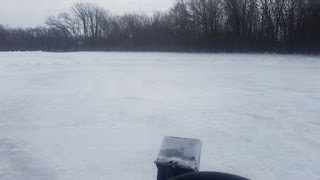We are fortunate our property drains well and has an extensive underground drainage system but every property has its limits and I think we have reached ours. I have been on the course since it expanded to 27 holes in 1996 and have seen wet periods and dry periods but this is the first time I have seen water just oozing out of hillsides and banks as we have the past 2 months. Hopefully some above average temperatures and normal rainfall will greet us next spring.
Rain coupled with temperatures well below normal has brought a early end to our golf season and sadness to the golfers hoping for one last round. Overall, we have to thank our hardworking grounds staff led by James Juoni and assisted by Jeremy Ruplinger on the work they have done to bring above average conditions in a below average weather year. What was accomplished in 2019? Lets look back:
The mat on the back of the range tee was replaced with new technology turf that will take a tee and provide a lie similar to turf. The mat isn't perfect compared to being on the natural grass tee but it is the best available.
 |
| Member Craig Peachy lends a helping hand in removing the old tee line. |
 |
| The material for the new tee line can accept a tee and provides a lie closer to real turf. Using the mat isn't ideal but a necessary evil when the turf on the regular tee is not growing or soft. |
Brushing our bentgrass greens help stand the grass up and provides for a cleaner cut. However brushing before mowing required a extra employee to come in early and do the extra work pulling a brush behind a cart. We could by an attachment for the greensmowers but they are thousands of dollars each and looked to be bulky and difficult for employees to work with in a timely manner. So James and Jeremy put their heads together to invent brushes that go on the front of the greensmower grass catcher buckets but are easy to remove on days we did not want to brush or to empty the buckets. For less than $200 we have a set for each mower saving money and providing better putting conditions. A win for everyone!
 |
| The brushes and buckets are labeled to match the custom made system with the correct bucket. |
 |
| The brushes come off in seconds to empty the bucket with ease or for days we do not brush. |
 |
| A view from the south shows the roof deck boards look the same today as they did in the early 60's when the barn was built. |
Besides extra grass to mow one good thing the fall rains gave us was greens aerification healed in record time. Aerifying any part of the course is not a happy time but especially the greens. With the abundance of growth from the rains most customers could not tell we had aerifyed greens a week after they were done. Aerification is a necessary evil to provide air pockets to help produce healthy turfgrass with increased drainage, and room for roots to grow.
 |
| Green Freshly Aerifyed |
 |
| Nearly healed in 5 days. |
Stringer work is underway as they rebuild the 6 20' sections.
5 rows of stringers will replace the 3 original ones to provide stability.
Thank you for your support through the year and we look forward to seeing you in 2020.





























